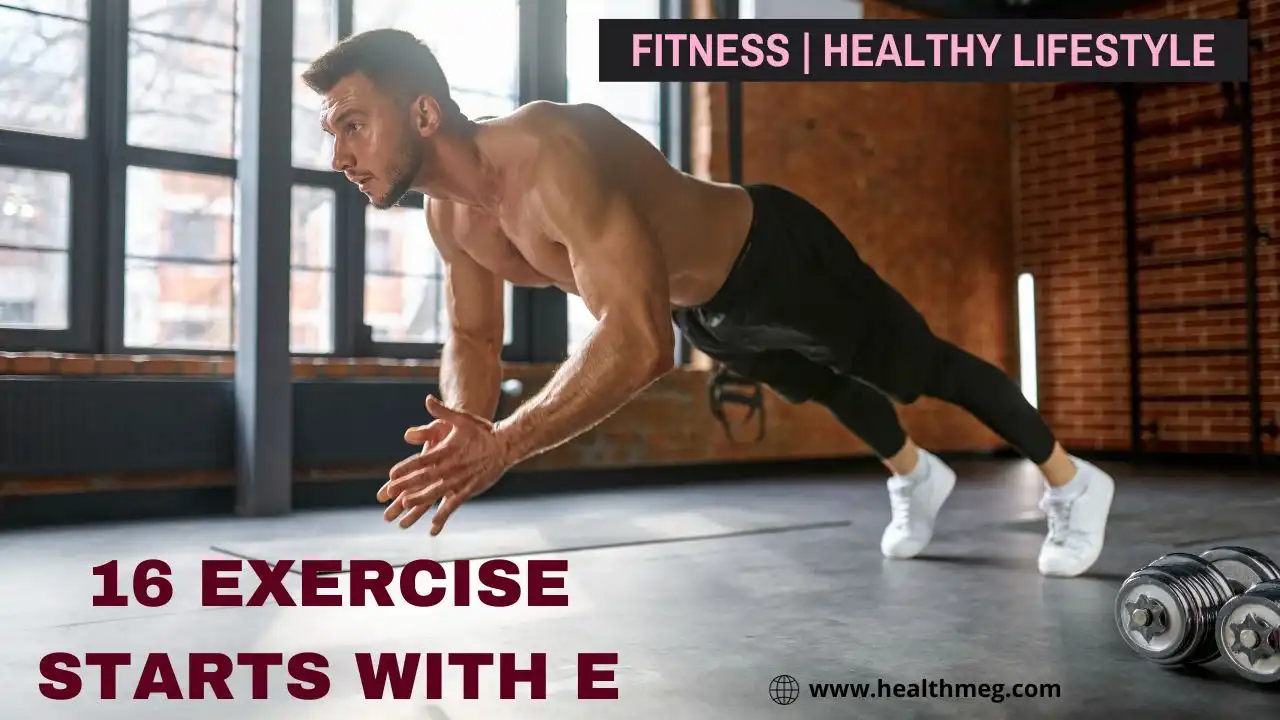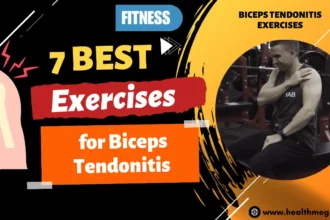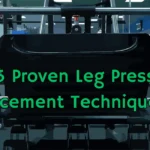Introduction
Exercise is essential for maintaining good health and fitness. While any movement is better than none, choosing targeted exercises that work multiple muscle groups at once can provide an efficient and effective workout. Exercises starting with the letter E encompass a variety of movements that target nearly every major muscle group in the body.
In this comprehensive guide, we will explore 16 different Exercises That Start with E, including explanations on proper form, primary muscles worked, and approximate calorie burn. With options for upper body, lower body, core, and full body exercises, there is something for everyone looking to get moving.
Do read the People Also Ask (FAQs) about this topic.
Key Takeaway
| Exercise | Key Takeaways |
|---|---|
| Elbow Plank | Targets core muscles like the abs, back, shoulders, and arms. Hold for time rather than reps. |
| Explosive Push-Up | Hits the chest, shoulders, and triceps. Increase power and difficulty. |
| Eagle Crunch | Works the upper abs and challenges balance/coordination. Avoid neck strains. |
| External Oblique Crunch | Zeroes in on obliques with controlled motion. |
| Elbow-to-Knee Crunch | Cross-body movement engages the abs and obliques. Modify the shins if needed. |
| Extended Lunge | Hits the quads, glutes, and hamstrings. Use weights to increase resistance. |
| Elevated Push-Up | Hits the triceps and chest. Start low and increase platform height. |
| Eccentric Heel Dip | Control is key to protecting Achilles. Hits calf muscles. |
| Elastic Band Pull | Row variation that targets back muscles. Bands increase resistance. |
| Elevated Feet Inverted Row | Hits the lats, biceps, and rear shoulders. Increase resistance by elevating feet. |
| Eccentric Single-Leg Deadlift | Strengthens posterior chain unilaterally. Brace core throughout. |
| External Rotation | Target rotator cuff for shoulder stability. Use little to no weight. |
| Elevated Reverse Lunge | Dynamic lower body exercise. Start low and increase step height. |
| Extended Side Plank | Challenges core and shoulders. Maintain rigid alignment. |
| Eccentric Step-Up | Emphasize control and lowering body weight unilaterally. |
| Eagle Pose | Improves balance, mobility, and stability. Proper alignment is key. |
Overview of 16 Exercises That Start with E
Here is a quick overview of the exercises beginning with E that we will cover in this guide:
- Elbow Plank
- Explosive Push-Up
- Eagle Crunch
- External Oblique Crunch
- Elbow-to-Knee Crunch
- Extended Lunge
- Elevated Push-Up
- Eccentric Heel Dip
- Elastic Band Pull
- Elevated Feet Inverted Row
- Eccentric Single-Leg Deadlift
- External Rotation
- Elevated Reverse Lunge
- Extended Side Plank
- Eccentric Step-Up
- Eagle Pose
This covers a wide variety of upper-body, lower-body, core, and full-body calisthenic exercises. Many can be easily modified by adjusting the level of difficulty or adding light weights to increase resistance. Let’s look at each exercise starting with E in more detail.
1. Elbow Plank
Explanation
The elbow plank is a staple core strength exercise that emphasizes endurance in the abs, back, shoulders, and arms.
How to Perform
To perform an elbow plank:
- Start in a push-up position but with forearms and elbows on the floor rather than hands. Engage your core.
- Keeping your body in a straight line from head to heels, hold the position as long as possible while maintaining controlled breathing.
- For modified versions, you can perform planks with knees on the floor or practice 30-second holds.
Muscles Worked
This exercise primarily targets the core muscles including the rectus abdominis, transverse abdominis, and obliques. The lats, traps, shoulders, triceps and forearms are also engaged for stabilization.
Calorie Burn
A 180-pound person will burn around 118 calories completing a 5-minute elbow plank.
2. Explosive Push-Up
Explanation
The explosive push-up takes the standard push-up to the next level by incorporating a powerful upward motion.
How to Perform
To do an explosive push-up:
- Start in a high plank position with hands slightly wider than shoulder width.
- Lower your body until your chest nearly touches the floor.
- Explosively push off the floor to launch your upper body upwards, releasing your hands momentarily.
- Land with control, reset your hands and repeat.
Muscles Worked
This exercise targets the pectorals, deltoids, triceps, and core for strength and power. Modified versions can be done from the knees.
Calorie Burn
A 180-pound person will burn around 90 calories completing 25 explosive push-ups.
3. Eagle Crunch
Explanation
The eagle crunch targets the upper abs while incorporating balance and coordination.
How to Perform
To do this crunch:
- Lie faceup with arms extended overhead, legs lifted and knees bent at 90 degrees. Engage your core.
- Reach your arms up and simultaneously lift your shoulder blades off the floor, extending your left leg out and crossing your right leg over to tap the toe to the left hand.
- Return to the start and repeat on the opposite side.
Muscles Worked
Unilateral crunches like this one improve stability in the core while targeting the rectus abdominis. Avoid pulling on the neck.
Calorie Burn
A 130-pound person will burn around 100 calories completing 100 repetitions of the eagle crunch.
4. External Oblique Crunch
Explanation
The external oblique crunch zeroes in on the sides of the abdomen to hit the obliques.
How to Perform
To perform this crunch:
- Lie on your back with your knees bent and feet flat. Extend your arms overhead angled towards one side.
- Contract your obliques to lift your shoulder and elbow up off the floor, aiming for the opposite side of your body.
- Return to start and repeat for reps before switching sides.
Muscles Worked
Focus on keeping the motion controlled and avoid pulling on the neck. This targets the external obliques.
Calorie Burn
A 180-pound person will burn around 90 calories completing 100 reps of this oblique crunching motion.
5. Elbow-to-Knee Crunch
Explanation
Adding a cross-body component, the elbow-to-knee crunch works your core and coordination.
How to Perform
To do this crunch:
- Lie face up with knees bent and feet lifted off the floor. Cross your right arm over your body.
- Contract your abs to lift your upper back off the floor, bringing your left elbow towards your right knee.
- Return to the start and repeat on the opposite side.
Muscles Worked
This targets the rectus abdominis and obliques while challenging your balance and control. Modify as needed by crossing at the shins instead of knees.
Calorie Burn
A 130-pound person can expect to burn around 125 calories by completing 200 elbow-to-knee crunches.
6. Extended Lunge
Explanation
The extended lunge takes the traditional forward lunge to new lengths, increasing lower body and core engagement.
How to Perform
To perform an extended lunge:
- Begin in a split stance with your front foot forward and your back knee hovering off the floor. Engage your core.
- Lower your back knee straight down towards the floor, bending both knees to 90 degrees.
- Drive through your front heel to return to start. Complete reps then switch sides.
Muscles Worked
This challenges the quads, glutes, hamstrings and calves while improving hip mobility and stability. Add weights to increase resistance.
Calorie Burn
A 180-pound person can expect to burn around 250 calories completing 100 extended lunges per side.
7. Elevated Push-Up
Explanation
Elevated push-ups place greater demand on the upper body by changing the angle of the exercise.
How to Perform
To do an elevated push-up:
- Place your hands on a stable elevated surface like a box, bench, or stack of books. Your body should form a straight line.
- Bending at the elbows, lower your chest towards the surface.
- Press back up until your arms are extended.
Muscles Worked
Elevating the hands increases triceps and pectoral activation. Start with a low platform and increase height to make them harder.
Calorie Burn
A 150-pound person can burn around 90 calories performing 25 elevated push-ups.
8. Eccentric Heel Dip
Explanation
The eccentric heel dip improves calf strength and ankle stability through an extended range of motion.
How to Perform
To perform eccentric heel dips:
- Stand facing a step or platform. Place the balls of your feet on the edge, heels extending off.
- Press up onto your toes, then slowly lower your heels below the step.
- Raise back to start and repeat. Keep your knees straight throughout the movement.
Muscles Worked
Control is key to protecting the Achilles tendon. This strengthens the gastrocnemius and soleus calf muscles.
Calorie Burn
A 160-pound person can burn around 50 calories performing 3 sets of 15 reps of eccentric heel dips.
9. Elastic Band Pull
Explanation
Elastic resistance bands add challenge to this back-strengthening row variation.
How to Perform
To do an elastic band pull:
- Sit or stand with feet hip-width. Wrap the band around a stable object at chest height.
- Holding the band with elbows bent, draw your shoulder blades down and back.
- Pull your elbows straight past your sides, engaging your back muscles. Return with control.
Muscles Worked
Focus on squeezing the shoulder blades together as you row. Bands increase resistance through the movement.
Calorie Burn
A 130-pound person can burn around 90 calories performing 100 reps of the elastic band pull.
10. Elevated Feet Inverted Row
Explanation
Elevating the feet during inverted rows increases the resistance for greater back and bicep activation.
How to Perform
To perform elevated feet inverted rows:
- Set up a bar or table around hip height. Place your feet on a bench or box with your body in a straight line angled back.
- Initiate the movement by pulling your chest towards the bar while engaging your back and biceps.
- Lower back down with control. Keep your body rigid throughout.
Muscles Worked
Elevating the feet increases resistance and encourages a full range of motion. This targets the lats, biceps and rear shoulders.
Calorie Burn
A 180-pound person can expect to burn around 200 calories completing 4 sets of 10 elevated feet inverted rows.
11. Eccentric Single-Leg Deadlift
Explanation
The eccentric single-leg deadlift develops unilateral strength and stability during the lowering phase.
How to Perform
To perform this exercise:
- Stand on one leg with knees slightly bent, leaning your torso forward. Raise the opposite leg straight back.
- Maintaining a flat back, slowly lower your torso while extending your raised leg behind you.
- Return to start by contracting your glutes and hamstrings to stand back up. Repeat on both sides.
Muscles Worked
Keep your core braced throughout the eccentric lowering portion to protect your back. This strengthens the hamstrings, glutes and erector spinae.
Calorie Burn
A 150-pound person can burn around 150 calories performing 3 sets of 10 eccentric single-leg deadlifts per side.
12. External Rotation
Explanation
External rotation targets the rotator cuff muscles to improve shoulder stability and prevent injury.
How to Perform
To perform this exercise:
- Hold a light dumbbell or band at your side with your elbow bent 90 degrees and fixed close to your body.
- Keeping your elbow stable, rotate your arm outward. Avoid arching your back.
- Return to the start position with control.
Muscles Worked
Focus on slow, controlled motion and keeping your elbow stationary. Repeat on both sides. Use little to no weight to start.
Calorie Burn
A 130-pound person can burn around 50 calories performing 3 sets of 15 external rotations with each arm.
13. Elevated Reverse Lunge
Explanation
Elevated reverse lunges increase lower body demands by adding a step-up motion.
How to Perform
To do this exercise:
- Stand facing a box or elevated platform. Step back with one leg, tapping your toes on the platform behind you.
- Lower until your front thigh is parallel to the floor while keeping your torso upright.
- Drive through the front heel and use your glutes to return to standing on the platform. Repeat on both sides.
Muscles Worked
This combo move engages the glutes, quads and hamstrings. Start with a lower height and increase difficulty over time.
Calorie Burn
A 180-pound person can burn around 300 calories completing 50 elevated reverse lunges on each leg.
14. Extended Side Plank
Explanation
The extended side plank variation challenges your core stabilizers as well as shoulder girdle strength.
How to Perform
To perform an extended side plank:
- Start in a side plank with one forearm on the floor. Stack your feet and lift your hips.
- Reach your upper arm directly above your shoulder, keeping your body in a straight line.
- Hold the position before gently lowering back down. Repeat on the opposite side.
Muscles Worked
Proper form is key. Engage your core and keep your hips lifted to avoid sagging. Start with short 10-second holds.
Calorie Burn
A 150-pound person can burn around 75 calories holding an extended side plank for 60 seconds per side.
15. Eccentric Step-Up
Explanation
Eccentric step-ups target the lowering phase to build unilateral leg strength and balance.
How to Perform
To perform eccentric step-ups:
- Place one foot on a box or step. Press through your heel to step up onto the platform with control.
- Slowly lower your opposite leg towards the floor with control, tapping your foot down.
- Drive through your front leg to return to the start position.
Muscles Worked
Emphasize balance and control as you eccentrically lower your body weight. Build strength and stability in the hips, quads, and glutes.
Calorie Burn
A 160-pound person can burn around 200 calories by performing 50 eccentric step-ups on each leg.
16. Eagle Pose
Explanation
Eagle pose is a balancing yoga posture that improves focus, chest mobility, and shoulder stability.
How to Perform
To perform the eagle pose:
- Stand with feet together. Cross your left leg over your right thigh, bringing your left foot behind your right calf.
- Raise your arms out to your sides. Cross your right arm under your left, bending your elbows and wrapping the arms together.
- Press your palms together. Focus your gaze on a fixed point to help balance.
- Hold for 30 seconds before releasing and repeating on the opposite side.
Muscles Worked
Proper alignment and control are key. This pose strengthens the ankles, hips and shoulders while stimulating concentration.
Calorie Burn
A 130-pound person can burn around 50 calories holding an eagle pose for 60 seconds on each side.
Conclusion
As you can see, there are endless exercise options that start with the letter E! By incorporating a variety of movements, you can achieve full body strength, balance, coordination, and calorie burn. Proper form and control are key, especially during unilateral and eccentric-focused exercises.
Listen to your body, modify exercises as needed, and focus on quality over quantity of movement. Aim for a targeted number of repetitions or time held rather than pushing to exhaustion. Start slowly and build up over time.
We hope this overview gives you some new ideas to switch up your routine. Exploring different E exercises allows you to challenge your body in new ways while honing your physical abilities and focus.
People Also Ask (FAQs)
Q) What does E mean in exercise?
A) E is commonly used as shorthand for eccentric exercise. Eccentric exercises focus on the lowering or lengthening phase of a movement, which helps build muscle strength and size.
Q) What is an exercise that starts with Y?
A) Some examples of exercises starting with Y include:
- Y raise – a shoulder exercise done with arms in a Y shape.
- Y squat – a squat variation with feet wide and toes turned out.
- Yoga poses – such as Warrior poses, Downward Dog, and Child’s Pose.
- Yardwork – raking, digging, and pushing a lawn mower can be good exercise.
Q) What is electric exercise?
A) Electric exercise refers to using electrical muscle stimulation (EMS) during a workout. EMS devices deliver low-voltage electrical impulses to muscle groups, causing involuntary muscle contractions. This allows users to activate muscles without actively having to contract them.
Q) What is the e-gym?
A) The eGym is a brand of smart electronic fitness equipment. eGym machines use digital technology to adjust resistance and guide users through workouts based on their goals and performance. This allows for more customized and interactive training compared to traditional equipment.












